1. Basic features
We have in our labs OCZ's second budget solid-state drive based on triple-level-cell (or TLC) flash. The new Trion 150 SSD is marketed as a "better" hard disk replacement and promises to offer up to 50% faster performance in many real world use cases such as large file transfers, compared to the previous Trion 100 SSD model.
This statement sounds a risky consodering that the Trion 150 SSD shares the sme specifications with the Trion 100 model, with an exection related to the NAND inside: The Trion 150 uses Toshiba's latest generation 15nm TLC NAND, compared to the 19nm TLC NAND of the Trion 100.

Just like the Trion 100 before it, the Trion 150 comes in 120GB, 240GB, 480GB, and 960GB flavors. In addition, the controller inside the Trion 150 hasn't changed - it's the same Toshiba TC58 found in the Trion 100.
Below you see the specs:
| Models |
OCZ Trion 150 |
OCZ Trion 100 |
| Capacities |
128GB, 240GB, 480GB, 960GB |
| NAND |
15nm TLC |
A19nm TLC |
| Controller |
Toshiba TC58 |
| DEVSLP Power |
6mW |
| Active Power |
4.8W |
| Encryption |
None |
| Endurance |
240TBW (New endurance specification measured using industry-standard JEDEC JESD219A client workload) |
| MTBF |
1.5M |
| Warranty |
3 yearShieldPlus |
| Performance |
| 120GB |
Sequential Read (MB/s) |
550 |
| Sequential Write (MB/s) |
450 |
| 4K Random Read IOPS |
79,000 |
| 4K Random Write IOPS |
25,000 |
| 240GB |
Sequential Read (MB/s) |
550 |
| Sequential Write (MB/s) |
520 |
| 4K Random Read IOPS |
90,000 |
| 4K Random Write IOPS |
43,000 |
| 480GB |
Sequential Read (MB/s) |
550 |
| Sequential Write (MB/s) |
530 |
| 4K Random Read IOPS |
90,000 |
| 4K Random Write IOPS |
54,000 |
| 960GB |
Sequential Read (MB/s) |
550 |
| Sequential Write (MB/s) |
530 |
| 4K Random Read IOPS |
90,000 |
| 4K Random Write IOPS |
64,000 |
We've got the Trion 150 480GB on hand for our review. Unfortunately, we did not have the chance to test the Trion 100 480GB drive in order to compare the new drive's performance figures to the old one's.
Besides the NAND Flash change and some firmware adjustments there really aren’t any new features on the OCZ Trion 150 series. All versions of the Trion 150 come with three years of OCZ's ShieldPlus rapid-exchange warranty coverage. And just like the Trion 100 480GB, the Trion 150 480GB is rated for 120TB of total bytes written, spread out across 110GB per day. The budget drive doesn't come with fancy extras like encryption acceleration in the controller.
The 480GB drive we're looking at sells for $129.99 on Newegg. The 120GB version will set buyers back $45.99, while the 240GB version rings in at $69.99 and the 960GB drive sells for $269.99.
2. Unboxing
The design of the TRION 150 as well as the packaging has changed since the 100. OCZ has gone with a sleek blue design for the package, with the SSD's name and capacity, while the backside lists the product specifications.

There isn’t much inside besides the SSD and an installation and warranty literature.

The new OCZ Trion 150 features an anodized aluminum housing, just like the previous-generation Trion. Of course, it size
conforms to the standard 2.5" form factor common to today’s SATA-based SSDs, and it has aslim 7mm Z-Height.


The controller supportd Toshiba’s QSBC technology (Quadruple Swing-By Correction, which is a Toshiba proprietary error correction technology) and the drive can use a bit of NAND as an SLC cache to boost short-term write performance and increase endurance. The Trion 150 also support DEVSLP to save power when idle, though the drives do not support hardware encryption.
Flipping the drive over you’ll find the actual product label of the Trion 150 that has the full part number, capacity, original firmware version, serial number and more typical stuff.

The Trion 150 has about 6.25% of their NAND capacity over-provisioned, though this can be tweaked in the OCZ Guru utility that’s available as a free download from the company’s website. That additional capacity is reserved for wear-leveling and other proprietary features.
The cache (TLC treated as SLC by writing only a single bit) equals approximately 1.5 percent of the total storage regardless of capacity. That means about we have about 7.2GB of cache, in the 480GB model we are testing. This kind of cache means that you ’ll hit the slower 3-bit writes to TLC during sustained transfers much sooner with the lower-capacity models.
OCZ’s SSD Guru is a cool utility that is free to download and it allows you to secure erase your drive, check its health, update the firmware and more. Below you see some screenshots of teh software with the Trio 150 480GB SSD installed in our test system.
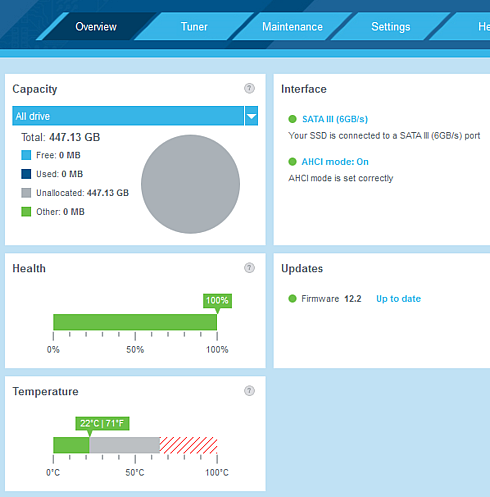

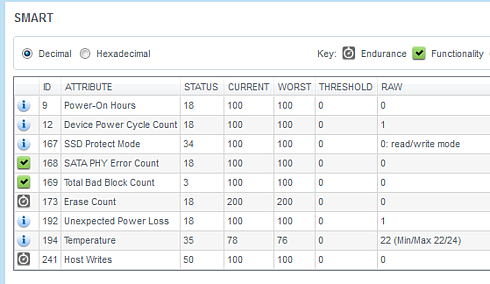


3. HDTachRW, ATTO Disk Benchmark
Here is our testbed:
- Shuttle SH81R4
Processor: Intel i7 4790Graphics card: Club3D Radeon HD 6790 CoolStream EditionMemory: 2x8GB RAM DDR3-1600 CrucialSSD: 512GB Crucial MX100Monitor: LG L246WH-BH 24"
- Windows 7 x64 SP1 with latest updates installed
We start the tests with the HDTachRW software. The software measures the sequential read speed, the random access speed and sequential write speed. The software feeds the tested drive a continuous string of small sequential requests. It doesn't equate to real-world maximum throughput, but it does mean something for analysis.
The drive's reading speed was consistent throughout its capacity and the average read speed was at 445.6MB/s. The software's small sequential requests in the write part resulted to an average speed of 300MB/s.
In the beginning of the test, the write speed was higher than 350 MB/s, as the SLC buffer used on the Trion 150 still filling up. A bit late the sustained period of writes exceeded the SLC buffer size and writing in the TLC portion of the drive was slower but steady, at about 300 MB/s. Unfortunately we do not have tested the Trion 100 SSD in order to make a comparison with the latest drive in this test.
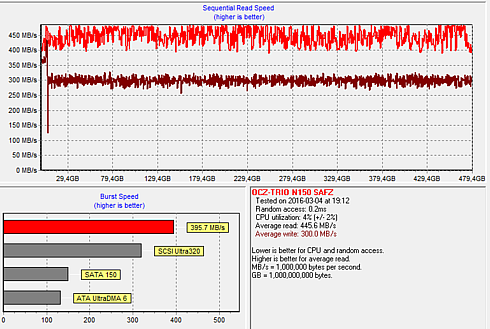
The next software we used was the ATTO Disk Benchmark. The tool measures storage systems performance with various transfer sizes and test lengths for reads and writes. The benchmark performs file transfers ranging from 0.5 KB to 8192 KB. ATTO can be adjusted to do overlapped I/O, in a variety of queue depths. The test was run with the default runs of 0.5KB through 64MB transfer sizes with the total length being 256MB and QD4. ATTO probably gives the most accurate results for compressible read and write data.
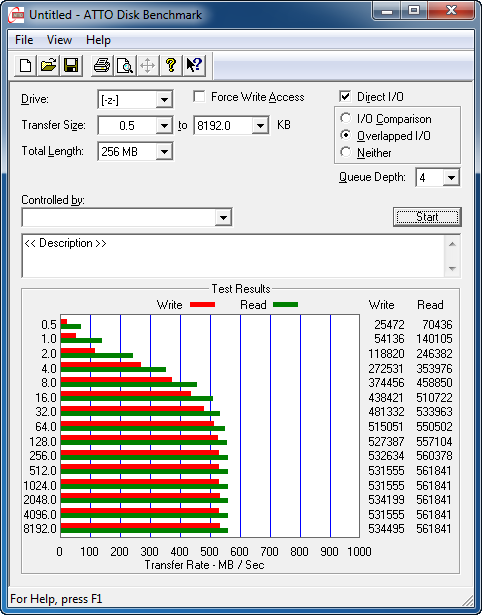
ATTO showed the OCZ Trion 150 480GB SSD maxing out at 562 MB/s read and 5345 MB/s write in the standard overlapped I/O benchmark.
Let's plot these results to make some comparisons with other SSDs.
The Trion 150 480GB SSD was surprisingly fast in the 4KB read test (353.9 MB/s) leaving behind the Samsung 850Pro 256GB, although the latter had a smaller overall capacity.

Reading of larger 2MB files was also fast at 561.8 MB/s. As you see below, many SSDs are competing in the 550 MB/s - 560 MB/s range, and their actual performance differences are obviously of no importance.
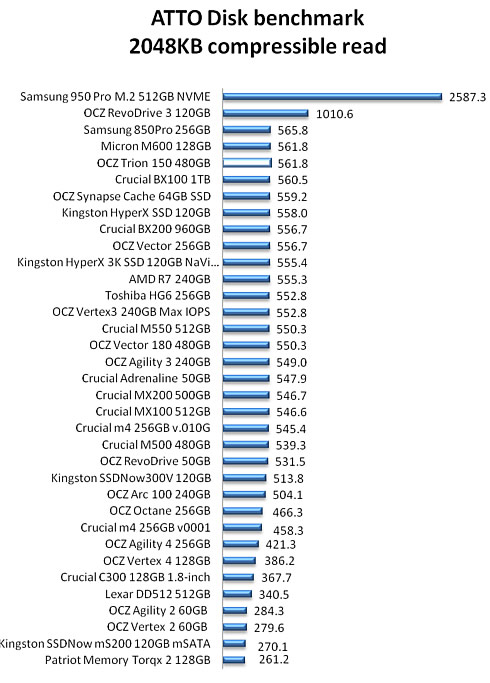
Writing of small 4K files was slower at about 272.5 MB/s, but the drive favored the larger 2MB files and returned a high write speed of 524.2 MB/s.

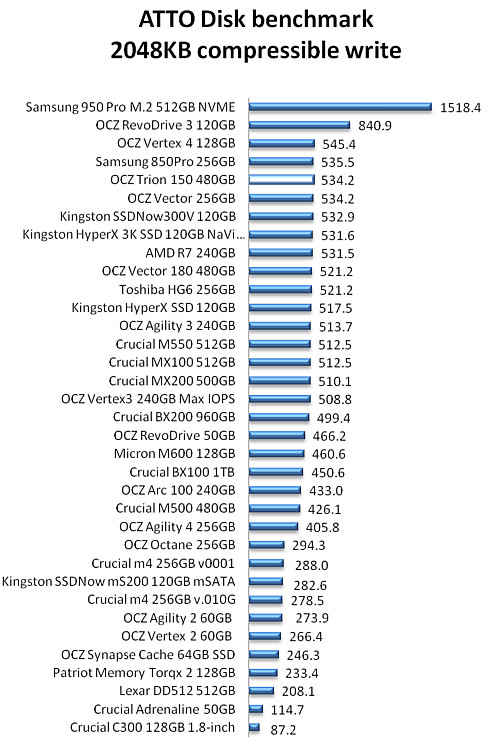
4. CrystalDiskMark
The next benchmark is the CrystalDiskMark. The software provides throughput data based on sequential reads and writes, and random (512K/4K/4KQD32) reads and writes of various sizes.
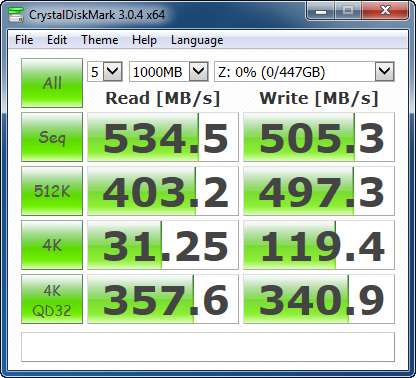
The OCZ Trion 150 480GB drive reached 534 MB/s read and 505MB/s write in the standard sequential write test. The Random 4K performance on the drive was 31.25 MB/s read and 119.4 MB/s write.
Interestingly, when we ran the test again set to 0Fill mode, the 4K read score shot up from 31.25 MB/s to 143.9 MB/s on the OCZ Trion 150. The rest of the results were practically unchanged:
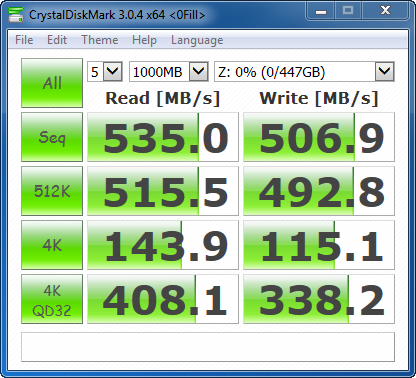
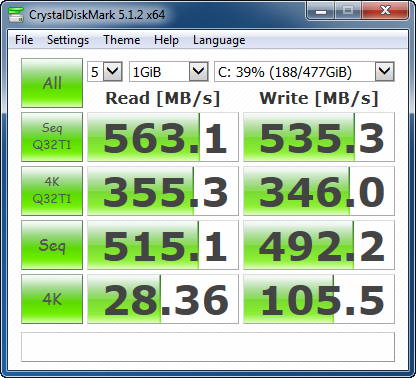
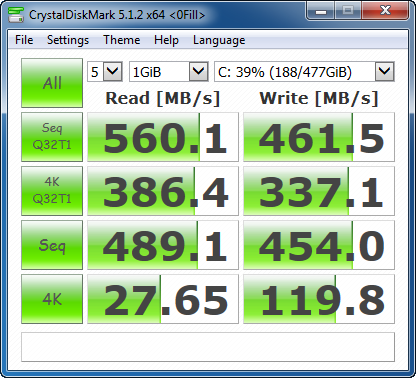
A class-leading performance performance for the Trion 150 480GB SSD in the sequential and 512K read tests, followed by an also impressive result in the 4K and 4K QD32 read tests:


In both the sequential and 512K write benchmarks the Trion 150 480GB SSD was positioned among the top performers of the charts below:

The Trion 150 SSD continued its good behavior in the 4K and 4KQ32 write tests, delivering respectable results, although its 4K write performance could be higher:

5. AS SSD benchmark
We move on with the AS SSD benchmark, which contains five synthetic as well as three practical tests. The synthetic tests determine the sequential and the random read / write performance of an SSD. These tests are carried out without using the operating system's cache. The Seq-test measures how long it takes to read and write an 1GB file. Most importantly, this sequential benchmark uses incompressible data for all of its transfers.
During AS SSD the Trion 150 480GB SSD reached a score of 814. Sequential speeds hit 514.7MB/s for reads and 495MB/s write while 4K speeds reached 40.32MB/s for read and 94.45MB/s for write. Access times are for read and write are both 0.031ms and 0.032ms, respectively.

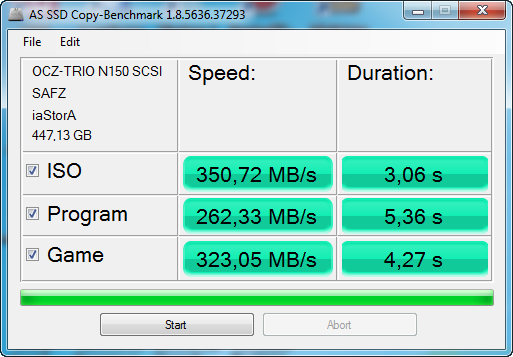
Starting with the read tests, the Trion SSD made it through the sequential read task well and was positioned close to the top of the chart below.

The drive showed exceptional performance in the 4K random read test, leaving many other SSDs behind:

The 4K 64 thread random read test was tougher for the Trion SSD, and it ranked well below the competition:

In the write tests, OCZ' s Trion SSD was very fast at the sequential test (495MB/s) ; it showed a decent performance at the 4K write tests (94.4 MB/s) and fell a bit behind the competition in the 4K random write (64 thread) test:
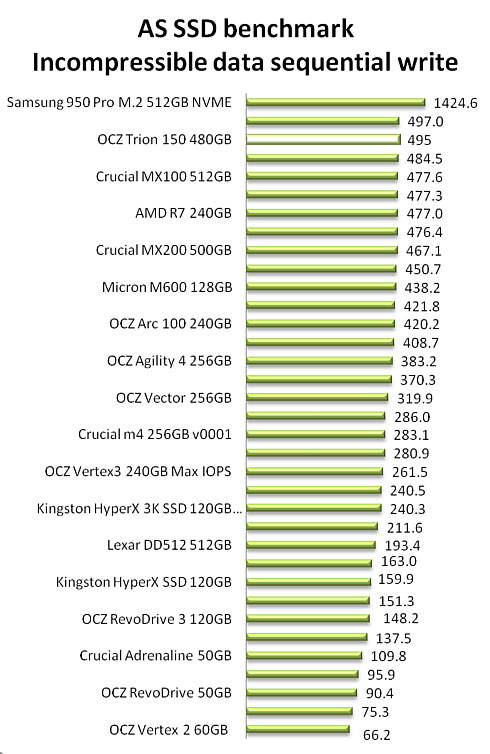

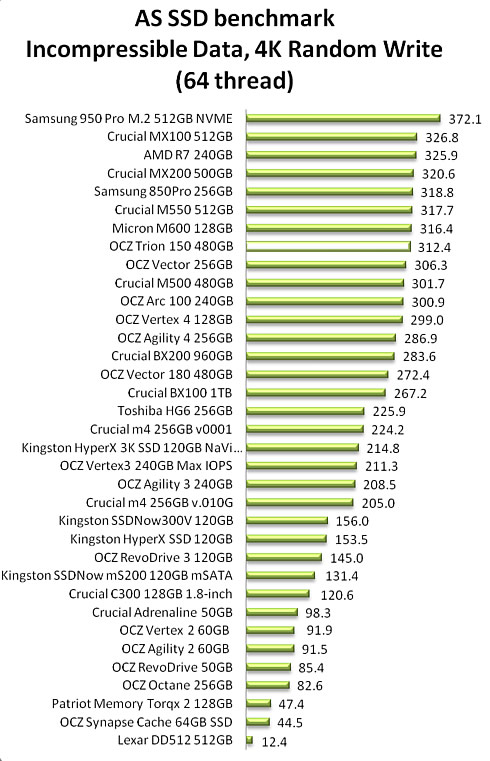
Next up we ran the Compression Benchmark built-into AS SSD. This test uses a mix of compressible and incompressible data and outputs both Read and Write throughput of the drive.
The Trion 150 480GB SSD showed a stable behavior across the board, save for a very slight dips of a few MB/s in the read test. The compressibility of data being transferred on the SSD had little to no impact on performance.

6. IOMeter
The IOMeter benchmark is run by using workstation and database patterns for queue depths (outstanding I/Os) representing very light and moderate loads. Iometer is both a workload generator (that is, it performs I/O operations in order to stress the system) and a measurement tool (that is, it examines and records the performance of its I/O operations and their impact on the system). The app's ability to bombard drives with an escalating number of concurrent IO requests also does a nice job of simulating the sort of demanding multi-user environments that are common in enterprise applications.

It looks like the specific benchmark was too demanding for the Trion 150 480GB SSD.
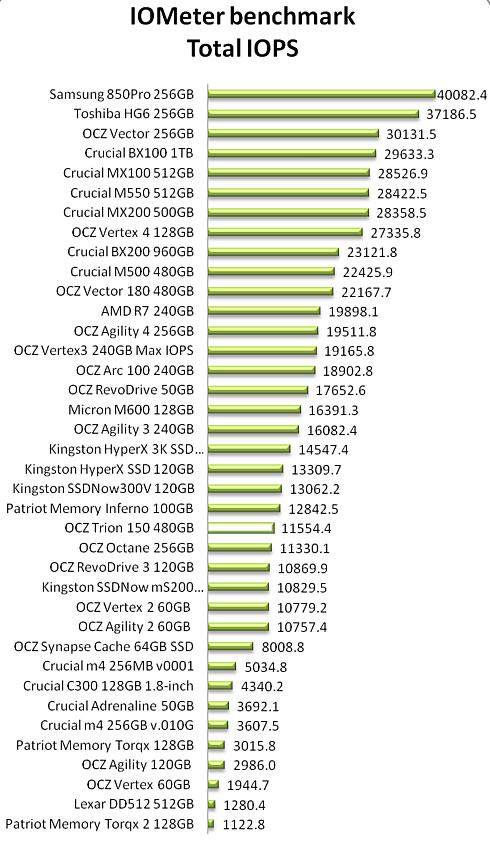


7. Anvil Pro
The next benchmark is the Anvil Pro, an ‘all inclusive’ storage utility. The software is tests transfer speeds as well as IOPS The IOPS tests can be configurable with preset testing scenarios for read (Seq 4MB, 4K, 4K QD4, 4K QD16, 32K and 128K), write (Seq 4MB, 4K, 4K QD4, 4K QD16) and mixed IO.
We used the software with the OCZ Trion 480GB SSD and tested the drive with 0-fill compression (RAW), 8% compression, 25% compression, 45% compression, 67% compression and finally 100 % (incompressible data).
Although the ASSD benchmark showed that the compressibility of data being transferred on the OCZ Trion 480GB SSD had little to no impact on the drive's performance, the results we got from the Anvil Pro benchmark were not so consistent across different compressions.
Starting with the 0-fill results (compressible), OCZ's drive got a very high overall score, which is based on both its read and write behavior. OCZ's SSD left behind the Samsung 850 Pro as well as Crucial's drives. This should be attributed to the very high overall read results, mainly in the 0-fill sequential 4MB, 4K, 4K QD4 and 4K QD16 tests.
In the 0-fill write results, the drive's sequential 4MB performance was good, but it could be higher in the remaining 4K, 4K QD4 and 4K QD16 tests. We should also note here that in the 4k write 0-fill write tests, the Trion 150 SSD was slower than in the corresponding test with incompressible data, and that its 4K QD16 0-fill write performance was low.



With incompressible data, OCZ's Trion SSD got an overall average score (read,write).
Specifically, it was fast enough in the 4MB Seq read tests, and remained competitive in the 4K read tests, although its performance was lowering as we were moving to higher queue depths.
In the write part, the Trion SSD was fast in the 4MB Seq test, but still slower than some other SSDs. It's 4K write performance was average.



8. PCMark 7, PCMark 8
PCMark 7's Secondary Storage benchmark module offers a real-world application measurement approach to testing. The benchmark offers a trace-based measurement of system response times under various scripted workloads of traditional client / desktop system operation. From simple application start-up performance, to data streaming from a drive in a game engine, and video editing, these tests illustrate the performance profile of SSDs in a consumer PC usage model.

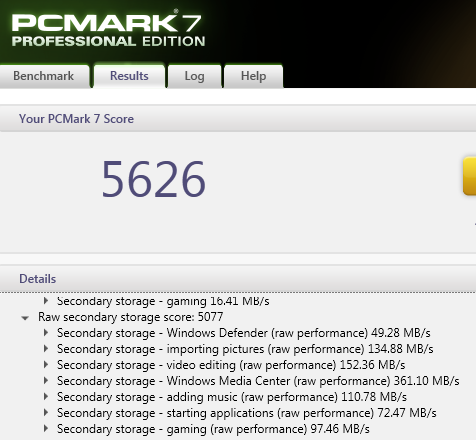
Below you see the secondary storage scores of some of the SSDs we have tested so far. The OCZ Trion 480GB SSD is not the faster performer, and trailed overall in the PCMark storage benchmark. The drive trailed mostly in the 'Starting Applications' portion of the benchmark:
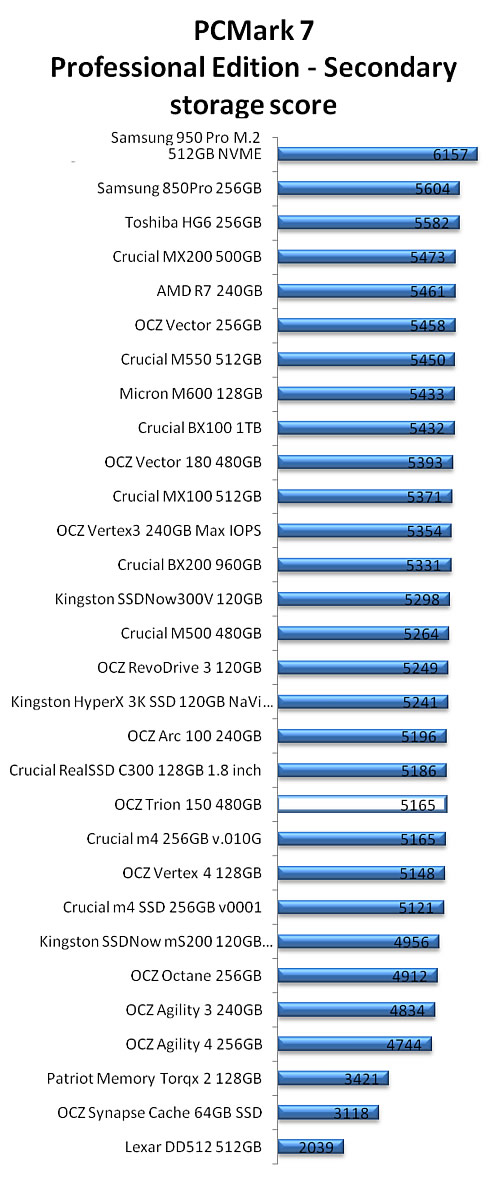
We continue with the PCMark 8 Storage benchmark, which uses traces recorded from Adobe Creative Suite, Microsoft Office and a selection of popular games. Unlike synthetic storage tests, the PCMark 8 Storage benchmark highlights real-world performance differences between storage devices.
We ran the storage benchmark test suite on the OCZ Trion 100 480GB SSD:

The overall score for the OCZ Trion 150 480GB SSD was just 4919 points, which is a pretty lower than the scores of other SSDs. If you look in the second chart below, you'll see than the Trion 150 SSD lagged behind the rest mainly in the Adobe tests.


9. Summary
Summarizing the results, OCZ's Trion 150 480GB SSD offered great performance in read tests although it could be faster in the write part, and delivers an overall good value, considering its retail price.
The drive gave some very high and competitive sequential read speeds, performed very well with 4K ~ 2MB transfer files (read) and almost perfectly in 4K random reads, although it was slowing down a bit when in 4K reads with higher than QD32 and QD64. Anvil Storage granted a great score to the Trion drive in the read tests, mainly with 0-fill data.
In the write part, sequential tests positioned the Trion SSD among the top performers in the category. On the other hand, the drive's performance with small 4K file transfers could be improved, especially in 4K random write 64 thread tasks. On the bright side, write transfers of larger MB files returned very good results.
We should also mention that the drive's performance in both the PC Mark 7 and PC Mark 8 benchmarks was lower than we expected, as the drive seems to be latency-sensitive with random workloads.
Street price for the Trion 150 480GB drive is currently $139.99 over Amazon.com. At this price, we have to do with approximately $0.28 per gigabyte for the new drive - a nice price if you are considering a SATA SSD for a system upgrade.
